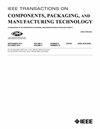一种分析回流过程中PCB翘曲的简化方法:关注翘曲变化和初始翘曲形状
IF 3
3区 工程技术
Q2 ENGINEERING, ELECTRICAL & ELECTRONIC
IEEE Transactions on Components, Packaging and Manufacturing Technology
Pub Date : 2025-03-16
DOI:10.1109/TCPMT.2025.3570867
引用次数: 0
摘要
印刷电路板(pcb)在回流焊接过程中经常由于热应力而发生翘曲。本研究提出了一种简化的方法来分析PCB翘曲,通过关注翘曲变化而不是绝对翘曲。由于定义温度载荷、边界条件和零应力-应变温度方面的挑战,绝对翘曲难以准确模拟。翘曲变化,比较了高温(例如,$150~^{\circ}$ C)和基线($30~^{\circ}$ C)下的翘曲,隔离了热变形并简化了模拟过程。该研究还介绍了一种图像处理方法,以准确识别每个PCB层中的Cu分布,这对于确定材料性能至关重要。该方法采用有限元法,结合Cu分布和初始翘曲量,提供了更加一致和可靠的翘曲量预测。仿真和实验结果表明,翘曲度变化是评估PCB热变形的更有效指标,为改进PCB设计和制造提供了有价值的见解。本文章由计算机程序翻译,如有差异,请以英文原文为准。
A Simplified Method for Analyzing PCB Warpage During Reflow: Focusing on Warpage Change and Initial Warpage Shape
Printed circuit boards (PCBs) often experience warpage during reflow soldering due to thermal stresses. This study presents a simplified approach to analyze PCB warpage by focusing on warpage change instead of absolute warpage. Absolute warpage is difficult to simulate accurately due to challenges in defining temperature loads, boundary conditions, and the zero stress-strain temperature. Warpage change, which compares warpage at elevated temperatures (e.g., $150~^{\circ }$ C) with a baseline ( $30~^{\circ }$ C), isolates thermal deformation and simplifies the simulation process. The study also introduces an image processing method to accurately identify the Cu distribution in each PCB layer, which is critical for determining material properties. Using finite element method (FEM) and incorporating both Cu distribution and initial warpage, this method provides more consistent and reliable warpage predictions. Simulation and experimental results demonstrate that warpage change is a more effective metric for evaluating PCB thermal deformation, offering valuable insights for improving PCB design and manufacturing.
求助全文
通过发布文献求助,成功后即可免费获取论文全文。
去求助
来源期刊

IEEE Transactions on Components, Packaging and Manufacturing Technology
ENGINEERING, MANUFACTURING-ENGINEERING, ELECTRICAL & ELECTRONIC
CiteScore
4.70
自引率
13.60%
发文量
203
审稿时长
3 months
期刊介绍:
IEEE Transactions on Components, Packaging, and Manufacturing Technology publishes research and application articles on modeling, design, building blocks, technical infrastructure, and analysis underpinning electronic, photonic and MEMS packaging, in addition to new developments in passive components, electrical contacts and connectors, thermal management, and device reliability; as well as the manufacture of electronics parts and assemblies, with broad coverage of design, factory modeling, assembly methods, quality, product robustness, and design-for-environment.
 求助内容:
求助内容: 应助结果提醒方式:
应助结果提醒方式:


